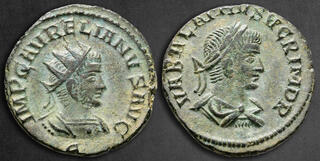| Savoca Numismatik GmbH & Co. KG > Online Auction 209 | Silver | Auction date: 28 April 2024 |
| Lot number: 501 Price realized: 80 EUR (Approx. 86 USD) Note: Prices do not include buyer's fees. | Show similar lots on CoinArchives Find similar lots in upcoming auctions on |
| Lot description: Aurelian and Vabalathus AD 270-275. Antioch Antoninianus Æ 21 mm, 3,46 g IMP C AVRELIANVS AVG //Є, radiate and cuirassed bust right / VABALATHVS V C R IM D R, laureate, draped and cuirassed bust right. Nearly Extremely Fine RIC V 381; RIC V online 3107. Septimius Vaballathus, born around AD 259 and died around 274 in Cologne, was the emperor of the Palmyrene Empire centered at Palmyra in Syria. He ascended to power as a child under the regency of his mother, Zenobia, who led a rebellion against the Roman Empire, establishing the independent Palmyrene Empire. Vaballathus, also known as Lucius Julius Aurelius Septimius Vaballathus, was born and raised in Palmyra as the son of Odaenathus, the king of Palmyra, and Zenobia, his second wife. Following the murder of his father and elder half-brother by a relative in 267, Vaballathus inherited the throne at the age of eight, with Zenobia acting as regent. Initially, the Roman Emperor Aurelian acknowledged Vaballathus' rule, likely due to other conflicts distracting Aurelian. However, tensions rose between the Roman and Palmyrene empires, leading to a series of Palmyrene conquests, particularly in Egypt and Anatolia, starting around 270. Despite initial successes, the Palmyrene Empire faced defeat at the hands of Aurelian's forces. After a series of battles and sieges, including the fall of Palmyra itself, Vaballathus and Zenobia were captured. The fate of Vaballathus remains uncertain, with some accounts suggesting he died on the way to Rome, while others claim he was paraded through the streets as part of Aurelian's triumph. The fall of Palmyra marked the end of its dominance in the region. Starting price: 50 EUR |  |


